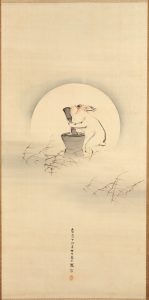
Mori Ippo (Japanese, 1798–1871), Rabbit Pounding the Elixir of Life Under the Moon, 1867, Ink and light color on silk, 40 1/2 x 20 in., Museum purchase, Friends of Asian Art, 92.20
Rising above a minimal landscape of reeds and clouds, a rabbit is silhouetted against the moon, busy at work using a mortar and pestle. In Japanese folklore, a mystical hare who inhabits the moon mashes ingredients for mochi, a traditional rice-flour cake. Japanese artist Mori Ippo (1798–1871) used ink and light color on silk to create this auspicious image associated with the celebration of a new year.
The tradition of making mochi originated in China thousands of years ago. By the Heian period in Japan (794–1192) it was well-established and considered to be a food closely associated with the divine, made both as an offering to the gods and for consumption by pilgrims at temples and shrines. Shops offering mochi would often be found near sites of worship, and a number still exist, some having sold these treats for more than a thousand years. One such is Ichiwa, a Kyoto-based mochi seller recently profiled in the New York Times.
Mochi-making is closely associated with the turn of a new year. The pounding of the rice and creation of these delicacies is a treasured family- and community-based culinary custom in Japan, with individuals taking turns at pounding sweetened, cooked rice into a smooth, pliable consistency. (Watch a YouTube video of rice pounding and the making of the mochi.)
Ippo was heir to a tradition of naturalistic animal painting in Osaka during the late Edo and early Meiji periods (mid-eighteenth through nineteenth centuries). His teacher, Mori Tetsuzan (1775–1841), was a son of the tradition’s founder, Mori Sosen (1747–1821), who was renowned for his depictions of the native Japanese macaque. Ippo married Tetsuzan’s daughter and was formally adopted into the Mori family, taking the family name. A well-regarded painter of landscapes, birds, and animal subjects, Ippo headed the Mori school in Osaka after his adopted father’s death.
–Lisa Rotondo-McCord, Deputy Director for Curatorial Affairs/Curator of Asian Art
NOMA is committed to uniting, inspiring, and engaging diverse communities and cultures through the arts — now more than ever. Your gift will make a direct and immediate impact as NOMA welcomes our community back to the museum and sculpture garden, plans new exhibitions, and develops virtual and at-home arts education resources for school partners.
